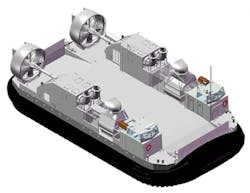Navy authorizes Textron to start building one of first LCAC replacement vessels
Officials of the Naval Sea Systems Command in Washington announced a $21.9 million contract modification Wednesday, to the Textron Inc. Marine & Land Systems segment in New Orleans to build Landing Craft, Air Cushion (LCAC) 101 of the ship-to-shore connector (SSC) program.
The LCAC is designed to move weapons, armored combat vehicles, equipment, cargo, infantry, and other military personnel to invasion beaches from amphibious assault ships offshore.
The specialized landing craft skims across the surface of the ocean on an air cushion, and can move at speeds faster than 40 knots. The entire hull rides about four feet above the ocean's surface.
Related: Navy asks embedded computing industry to supply 83 6U VME32 circuit cards for LCAC
The SSC program will replace the existing fleet of 73 LCAC vessels, which are nearing the end of their 30-year service lives, Navy officials say. The SSC LCAC replacement vessels will land warfighters and equipment from the sea at over-the-horizon distances while operating from amphibious ships and mobile landing platforms.
SSC LCAC replacement vessels will provide increased performance to handle current and future missions, as well as improvements which will increase craft availability and reduce total ownership cost, Navy officials say. The program will increase the LCAC's payload from 60 to 74 tons.
Textron Marine & Land Systems originally won a potential $570.5 million contract (N00024-12-C-2401) in July 2012 to kick off the SSC program by designing and building SSC test and training craft.
Before the SSC program, Navy officials had been upgrading LCAC electronics and other equipment in the The LCAC C4N to replace obsolete equipment on the LCAC, focusing on replacing the vessel's LN-66 radars with modern, high-power P-80 radar systems.
Related: Navy chooses 6U CompactPCI single-board computers from Concurrent for LCAC C4N
LCAC C4N focused on open-architecture systems with modern commercial-off-the-shelf (COTS) equipment. LCAC C4N contractors included Aitech Defense Systems Inc. in Chatsworth, Calif., which provided single-board computers; Concurrent Technologies in Woburn, Mass., which will provide single-board computers; and Tracewell Systems in Westerville, Ohio, which provided rackmount chassis.
Last July officials of the Naval Surface Warfare Center (NWSC) in Panama City, Fla., issued a solicitation for as many as 83 6U VME32 LCAC control cards over the next five years for the LCAC system.
On the contract modification announced this week, Textron will do the work in New Orleans; Huntington Beach, Calif.; Chanhassen, Minn.; Coronado, Calif.; and Minneapolis, and should be finished by August 2017.
For more information contact Textron Marine & Land Systems online at www.textronsystems.com/businesses/marine-land, or Naval Sea Systems Command at www.navsea.navy.mil.
